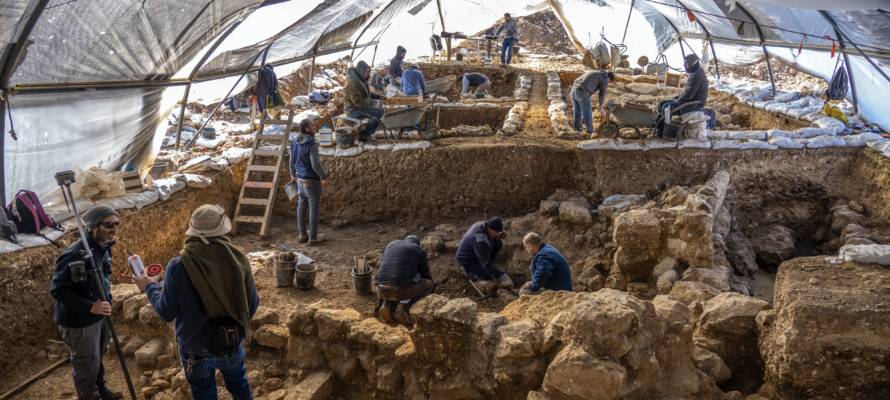Israeli archaeologists discovered a trove of artifacts in Jerusalem dating back to the time of the biblical King Hezekiah during the First Temple period.
By Ezra Stone, United with Israel
Over 120 seal impressions stamped on jars were recently discovered near the US Embassy in Jerusalem dating back about 2,700 years to the era of the Judean kings.
According to Jerusalem District Archaeologist of the Israel Antiquities Authority (IAA) Dr. Yuval Baruch, “The archeological discoveries at Arnona identify the [location] as a key site – the most important in the history of the final days of the Kingdom of Judah and of the return to Zion decades after the destruction of the Kingdom.”
Dr. Baruch notes, “This site joins a number of other key sites uncovered in the area of Jerusalem which were connected to the centralized administrative system of the Kingdom of Judah from its peak until its destruction.”
The artifacts “provide a sneak peek into tax collection” during that period, explains a statement from the IAA, which supervises the site where the discoveries were made.
The IAA described the site as an “unusually large structure built of concentric ashlars walls” where “120 jar handles were found bearing seal impressions containing ancient Hebrew script.”
“Many of the handles bare the inscription ‘LMLK’ (‘To the King’) written in ancient Hebrew script, with the name of an ancient city, while others feature the names of senior officials of the Kingdom of Judah or wealthy individuals from the First Temple Period.”
The IAA continued, “This is one of the largest and most important collections of seal impressions ever uncovered in archaeological excavations in Israel.”
The IAA identified the site as a “significant administrative storage center from the days of Kings Hezekiah and Menashe,” which is located near the modern day U.S. Embassy complex in Jerusalem’s Arnona neighborhood.
‘One of the Most Significant Discoveries from the Period’
According to excavation directors Neria Sapir and Nathan Ben-Ari, “This is one of the most significant discoveries from the period of the Kings in Jerusalem made in recent years. At the site we excavated, there are signs that governmental activity managed and distributed food supplies not only for shortage but administered agricultural surplus amassing commodities and wealth.”
The archaeologists continued, “Evidence shows that at this site, taxes were collected in an orderly manner for agricultural produce such as wine and olive oil. The site once dominated large agricultural plots and orchards of olive trees and grape vines which included agricultural industrial facilities such as winepresses for winemaking.”
By way of background, Sapir and Ben Ari explained, “The site is dated to a period documented in the Bible by upheavals such as that of the Assyrian conquest campaign – under the command of King Sennacherib in the days of King Hezekiah. It may be that the government economic provisions indicated by the stamp seals are related to these events however, the excavation revealed that the site continued to be active after the Assyrian conquest.”
Moreover, “The array of stamped seals indicated that the system of taxation remained uninterrupted during this period. It is interesting to note that some of the storage jar handles area inscribed with the names of senior officials and wealthy individuals from the Kingdom of Judah – Naham Abdi, Naham Hatzlihu, Meshalem Elnatan, Zafan Abmetz, Shaneah Azaria, Shalem Acha and Shivna Shachar.”
These same names appear on other jar handles found across the Kingdom of Judah and “attest to the elite position of those whose names are impressed on the jars,” indicating that these men might have been “senior officials who were in charge of specific economic areas, or perhaps wealthy individuals at that time – those who owned large agricultural lands, propelled the economy of their district, and owned private seals.”
Connection to City of David
The IAA notes, “The excavators also posit that the large number of seal impressions at the site clearly indicate that during the latter part of the Kingdom of Judah, governmental activity took place in the area south of the City of David. It is also possible that this governmental activity was related to the nearby site of Ramat Rachel, which may be identified with the palace of the Kings of Judah and/or as an administrative center.”
Most of the seal impressions found contain the Hebrew letters “LMLK” and are “characterized by a sun disk, flanked with two wings,” above which “the word ‘to the King'” is written and and below which appears “one of four cities in the kingdom of Judah: Hebron, Ziph, Socho or Mmst.”
According to Sapir and Ben-Ari, “While the identification of Hebron, Ziph and Socho can be identified with known ancient cities in Judea in the Hebron Hills area however, the identification of Mmst is still controversial.”
The IAA added, “During the ancient period, for reasons not understood, the large building at the site was covered over with a massive pile of flint stones forming an artificial hill measuring 20 meters high and extending over seven dunams. Even today, this huge pile of stones stands out from the surrounding hills and is visible from a great distance.”
According to the researchers, “These artificial stone hills have been identified at several sites in Jerusalem and are a phenomenon to the end of the First Temple period and have aroused the curiosity and fascination of Jerusalem researchers since the beginning of archeological research in the area. Nevertheless, the reason for the huge effort made in stacking them over many acres remains an unresolved archaeological mystery.”
